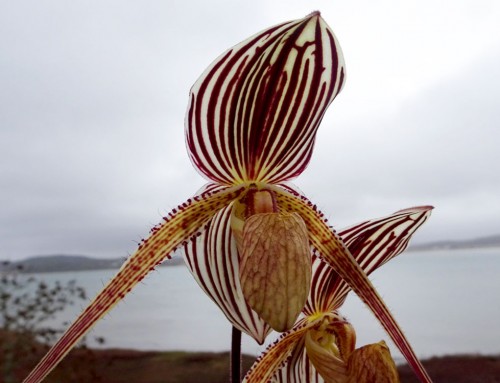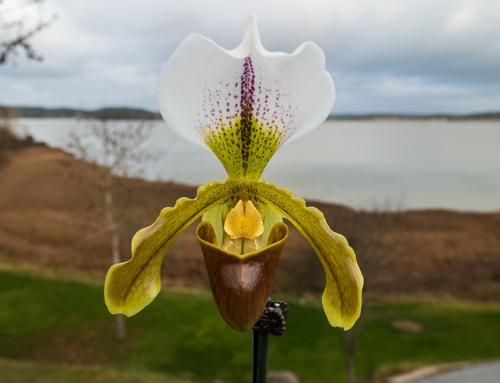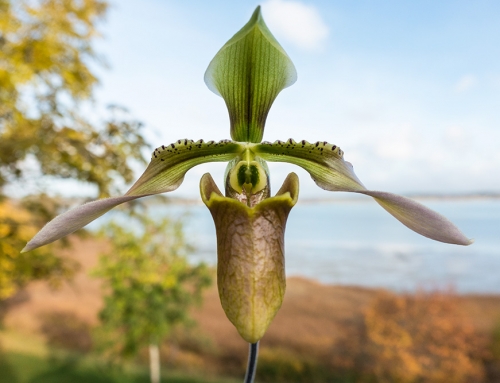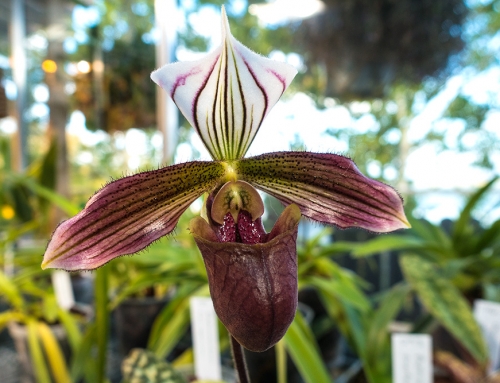 …because almost all of my Masdevallias are blooming now. I have an aquarius hybrid that has been blooming non-stop since May 2008! Another, a small Masdevallia guttulata – truly a perpetual bloomer – is working on on flower number 9 on the same inflorescence at the moment. Only the two winter blooming tovarensis are not in bloom right now. We’ve had a bit of a cold spell for a few weeks now and the Masdie collection is lovin’ it. I grow all my Masdevallia on the windowsill in sphagnum moss (a few in vulcaninc rock – an experiment).
…because almost all of my Masdevallias are blooming now. I have an aquarius hybrid that has been blooming non-stop since May 2008! Another, a small Masdevallia guttulata – truly a perpetual bloomer – is working on on flower number 9 on the same inflorescence at the moment. Only the two winter blooming tovarensis are not in bloom right now. We’ve had a bit of a cold spell for a few weeks now and the Masdie collection is lovin’ it. I grow all my Masdevallia on the windowsill in sphagnum moss (a few in vulcaninc rock – an experiment).
The one I am the most excited about is actually a mistake. I got this in June from Orchidéhuset in Sweden, but Karge is the actual grower. I thought I had bought a Masdevallia calura, but now when the first flower appeared it is clear that it isn’t a calura but rather a rolfeana (thanks Daniel from Costa Rica for pointing that out). Both species are from Costa Rica and although similar in color, the shape of the flowers and their growing preferences are quite different. The small rolfeana enjoys windy cloud forests at elevations of 1400 to 2200 meters and blooms during the cold season. The mini calura prefer mountain rain forests at elevations of 200 to 2000 meters and flowers in the summer. Well, at least I have 1 to 3 successive flowers per inflorescence to look forward to with the rolfeana so that is a bonus. Even though it really bites when you don’t get what you order I cannot complain too much about this one, it is simply beautiful! …oh, but I still want a calura…
The other one I am really proud of right now is Masdevallia herradurae. I got this from Orchids & More last November. As soon as the temperatures dropped a bit this fall came the flowers. So far 6 deep burgundy flowers with orange tips and I think there might be more coming. This miniature warm to cool growing epiphyte grows in the mountains of Colombia and Ecuador at elevations of 500 to 2100 meters. It’s got a bit strange looking flowers that grow below leaf height. It is a floriferous species which means that even older leaves can bloom several years in a row. Nice.
On a sadder note, I think my little Masdevallia picturata finally kicked the bucket after battling some brown rot from this summer when it got a bit too hot and stagnant in the room… damn.










Hi Karma
Orchids never cease to amaze me! Is it in their nature to be perpetual bloomers?
I’ve never grown one, but i may have to get one real soon . yours are gorgeous! oh,
and are they fragrant? Ha en trevlig helg! Did i say that right, lol? Or would you just say trevlig helg?
Sorry to bust out some swedish on you, now and then, Karma. I want to learn some new languages, plus dear hubby is swedish descent, and i hope we can go on holiday, in the near future to Sweden. Even though you guys speak perfect english, i think it’s always good to learn the local language. i think its respectful, and you gain such a better experience of your surroundings. i learned that from being an army brat, and living overseas. i wish there was a greater push for americans to learn languages, like they do in other countries.
But that is waayy off subject here on your wonderful blog! Yay orchids!! Trevlig helg Karma! lol.
Thanks Joan. Well, wouldn’t it be nice if all orchids were perpetual bloomers, lol. When you get a few that never seem to want to stop blooming you better care for them well. Flowering machines (blommaskiner = swedish expression) are few and far in between. I’ll try and get a better photo of mine. I counted 20 flowers on it this morning, it is quite stunning. None of my Masdevallias are fragrant. Trevlig helg – yes you did very well. You can say either “have a”/”ha en” trevlig helg or just trevlig helg, either one works just fine. Hope you get to see Sweden some day it is beautiful here. Take care!
if you are growing tropical orchids in sweden, perhaps it is not about the season (as plants got to another world) but it is about a notorious improvement on the growing technique =) After growing M calura for many years, Ive found this is a perpetual blooming plant, and I had seen that in just a very few other local and exotic Masdevallias, I also remember M molossoides at this time.
Think everybody can grow very fine a M calura plant as it is a strong growing species, it supports from a permanent shaded place to some 50/50 direct sun light condition (leaves dont get burned), as well as from damp growing conditions (as my friend’s place Felix, next to Zurqui mountain) to some months of dramatic dryness as it happens on outdoors conditions at my backyard from december to may. The same goes for other strong and beautiful species like M demisa, M striatella, M laucheana (the coconut smell M.), etc.
I had only grown these plants in trunks (orange tree trunk and Acnistus arborescens trunk) and believe me, those get really dried out by those months.
Last time I saw M calura in situ, it was at Santa Cruz Turrialba, 1700 meters high, there were a lot of them growing on the base of some old trees, and cows had eaten them a lot, so, they are not only exotic display plants but cow pasture =) . Same thing as some Draculas and Masdevallias zalbrucknerii I saw at Santa Maria Dota in January, cow food …
Hi Daniel, I am happy to see you here as well. I believe you are absolutely right and the location does not matter as much as the technique and the lenths we go to accommodating tropical growing in places such as Sweden… I suppose you don’t have to work quite as hard to make this happen where you live. Interesting to hear that the M. caluras you have grown have been perpetual bloomers too. That makes me want a real calura even more! I am a little jealous that you get to see these incredible orchids in the wild – it must be a beautiful sight! But I think I might have an aneurysm if I saw a cow make a quick lunch out of a field of gorgeous Masdevallias!! :O
I believe you are absolutely right and the location does not matter as much as the technique and the lenths we go to accommodating tropical growing in places such as Sweden… I suppose you don’t have to work quite as hard to make this happen where you live. Interesting to hear that the M. caluras you have grown have been perpetual bloomers too. That makes me want a real calura even more! I am a little jealous that you get to see these incredible orchids in the wild – it must be a beautiful sight! But I think I might have an aneurysm if I saw a cow make a quick lunch out of a field of gorgeous Masdevallias!! :O
I have to keep an eye out for some more nice Costa Rican Masdies, starting with the M demisa, M striatella and M laucheana you mention. Interesting to hear about the extended dry season… I generally water less accross board in the winter since there is less light – even with my artificial lights on. But I usually keep the Masdevallias pretty evenly wet. Perhaps I should let them dry up a bit more in the winter as well. I have to read up on the species I have some more and do some experimenting.
I read a great tirade about this thing with light and tropical orchids on a forum a few years ago (scroll down a bit to the answer by howard a). But he basically says that all the problems we encounter growing tropical orchids in northern hemisphere is a direct result of inadequate lighting and we have learned to abuse or trick our orchids into growing under the conditions we can provide. “The light available in many regions is simply insufficient to sustain tropical orchids even in a greenhouse. Luckily workarounds have been discovered. Systematic underwatering is one of them. (Even though) it is the exact opposite of what the orchids want… …If properly lit a normal, even insane amount of overwatering is not harmful. Overwatering is not the reason orchids sicken. Lack of light, lack of adequate temps, anything but too much water.”
Hi Karma
Incredible flowers. WOW. I’ve been growing Masdevallias now about 3 year, without any notable blooming. Do you really grow them only on spaghnum ? No other components ? Mine are in bark and sparghnum but they don’t grow too well. I also kept them in absolutely too cold conditions last winter, untill I saw some in Cape Town growing well in much much higher temperatures. Thank you for giving me good hints, I just got a bottle of japonica and now they grow in spaghnum. The best thing here in Finalnd is that I can collect spaghnum right from my own forest. As much as I want. But tha’s the only good thing, there’s no light at all or too much light during the summer etc problems. Hope to get my massies bloom as beaautifully as yours do right now – growing in spaghnum.
Hi Taneli. Thank you very much! I have tried a few different growing mediums (most recently semi-hydro volcanic rocks) but I have found that they really do best in just sphagnum moss. Same for the flask babies. I usually put a little leca in the bottom of the pots (but I do that with all my pots, regardless of what medium I use) to make sure they drain well, but other than that just loosely with moss. How nice that you can just go out and pick living moss. I use the dried stuff from either New Zeeland or Chile, and it works really nicely too. I try to select Masdevallias that grow on lower elevations since they are more tolerant to warmer temperatures, but since my M. calura turned out to be a rolfeana that is not entirely true… M. rolfeana enjoys quite high elevations, 1400 to 2200 meters, and it still bloomed for me – nice plant. I think it is more important to give the cool growers cool nights than cool all the time. As long as you can provide 10-15 degrees cooler nights than days and good air circulation I think they will do ok even in intermediate growing conditions such as mine. Good luck with your Masdevallias and the japonica babies!
Hi Karma,
I have been struggling to grow Masdevallia for years. I gave up, after killing (4) Mounted species. I am trying now again, and am determined to succeed. I grow exclusively on my 3 large windowsills. I think this time around, I will try and only grow hybrids, although right now I am struggling to keep (2) Masd. decumana alive, and (2) Masd. floribunda.
Can you share how you grow so successively on windowsills ?
Thanks.
Hey Patrick. I think you will have a very hard time succeeding with growing mounted Masdevallia on the windowsill… Masdevallia do best in high relative humidity, and they never want to dry out completely. You need to have a really high humidity environment (green house or vivarium) to grow mounted plants well, you will do much better if you pot them in pure sphagnum moss. That way you have to struggle less to keep them evenly moist. You would do good to invest in a humidifier, try to keep RH at 60% (preferably even more) at night when the plants breathe. Also try and get a decent diurnal temperature difference, strive to of 10C or so degrees cooler at night. I accomplish this by cracking a window open at night and closing the door to the growing room at night to keep cool air and humidity in the room. Some hybrids may be easier, otherwise look for species that grow at lower altitude, they can handle warmer temperatures and won’t need as much diurnal temp. difference to thrive… Good luck!